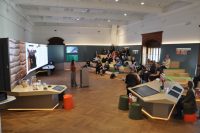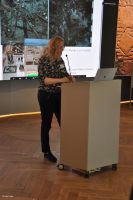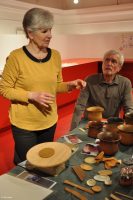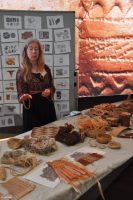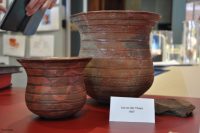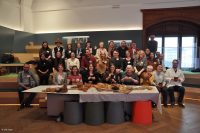A Bell Beaker workshop in Vienna

Blog post by Eve Derenne and Karina Grömer
On March 21, 2023, members of two partner institutions from the HEAS network — the Vienna Institute for Archaeological Science and the Natural History Museum Vienna — co-organised a workshop titled ‘Interweaving Bell Beaker decorative motifs and textile patterns: Exploring technical and symbolic productions during the third millennium BCE in Europe’.
The idea for this workshop emerged in September 2022, when Priv.-Doz. Dr. Karina Grömer (Head of the Prehistory Department at the NHM) and Dr. Eve Derenne (postdoctoral fellow, VIAS) met by chance in Hallstatt during a science communication event, the ‘Archäologie am Berg’ day. The conversation regarding the reconstruction of Bronze and Iron Age textiles shifted to the subject of Bell Beakers, a crucial component of SEASCAPES, the project currently occupying Eve’s time in Vienna. The intricate motifs found on both Bell Beaker pottery and anthropomorphic stelae have often been compared to textile patterns, but few if any publications have really substantiated that claim. Several aspects of this topic have also remained unexplored, such as the weaving or fiber working methods used to produce these repeated geometric patterns, and whether these techniques were already established by the third millennium BCE. This lively discussion ultimately resulted in an agreement to hold a workshop that would bring together experts from both fields, with the aim of answering some of these lingering questions.
Six months later, a gathering of Bell Beaker and textile researchers, conservation experts and craftspeople convened in the Deck 50 room of the Natural History Museum — a recently inaugurated science communication hub that provided an ideal venue for the workshop. The day was divided into two: a first session with short scientific talks on the Bell Beaker phenomenon (9:00–13:30), also accessible online, and an afternoon session dedicated to experimental archaeology and hands-on activities.
The number of in-person attendees was voluntarily limited to allow for easier discussions and exchanges between the participants during the hands-on session, and this is how about 25 people met on that Tuesday. The hybrid session allowed an additional ~35 international attendees to join online and interact with the speakers. What started as an idea for a small, informal workshop with 10–12 in-person participants had grown into a 60-person event!
Scientific talks from all over Europe
In addition to Eve and Karina’s introductory talks summing up the current state of research on the Bell Beaker phenomenon and prehistoric textiles in Europe, presentations covered a range of topics and methods: analysing the motifs on the famous Bell Beaker stelae of Sion ‘Petit-Chasseur’ (M. Besse, University of Geneva), detailing the manufacturing techniques of Bell Beaker ceramics from northwestern France (Q. Favrel, Eveha), connecting Bell Beaker motifs with their potential symbolic meaning (J. Turek, Charles University Prague), synthesising the Bell Beaker styles from western Iberia and their possible forerunners (M. Kunst, retired from the German Archaeological Institute in Madrid), identifying Bell Beaker maritime networks on the basis of recurring decoration motifs in the western Mediterranean (L. Frank, University of Vienna), using deep learning as a tool to distinguish between two different Bell Beaker decoration techniques (R. Paulos-Bravo, Complutense University of Madrid & G. Cifuente-Alcobendas, University of Alcalá), linking Bell Beaker pottery and baskets with salt production in Iberia (E. Guerra Doce et al., University of Valladolid, UNED, and Universitat Autònoma de Barcelona), illustrating Bell Beaker encrusted ceramics to visually render their initial look (L. Gucsi), and detailing cloth cultures and textile production in Prehistoric Europe (S. Harris, University of Glasgow).
A fabulous hands-on session
By all accounts, however, the highlight of the day was the afternoon session, with its four themed tables:
- Bell Beaker artefacts at the NHM, temporarily removed from exhibition hall 11 and accompanied by other finds from the storage rooms that are typically inaccessible to the public, as well as historical documents explaining the contextual background of each archaeological object (Caroline Posch, Walpurga Antl, Vinzenz Kern, & Daniel Oberndorfer, NHM Vienna)
- Experimental pottery making to reproduce Bell Beakers, from shaping to decoration and finishing treatments (Vera & Ludwig Albustin, Austria)
- Experimental textile making based on known prehistoric techniques: rep band weaving, tabby weaving, tablet weaving, embroidery (Kayleigh Saunderson, University of Vienna)
- Experimental bast fiber work based on attested prehistoric techniques: twining, net and basket making, etc. (Dorothee Olthoff, PRAE, the Netherlands)
Although three hours had been allocated for the participants to visit each table, question the specialists and try some of the techniques themselves, the afternoon felt way too short, and one almost wished to have four times 3 hours to spend experimenting with clay, wool yarn, linen thread or strands of bark fibers!
Concluding the workshop: A few answers, and more questions!
- A few key takeaways from this workshop were summarised at the end of the workshop, during a collective discussion with all speakers and participants. Some of the questions asked were:
- Which Bell Beaker motifs are reproducible with which known techniques? It seemed that some of them could easily be created using simple twining (crossing two strands of fibers around more rigid elements — a technique used on most of Ötzi’s clothes), plain weaving with float weaves (using different coloured threads and ’omitting’ several of them while weaving, to create simple geometric patterns, as evidenced in Lago di Ledro for the Early Bronze Age), or embroidery.
- Did the textile depictions on the engraved stelae and statue-menhirs from Northern Italy and Switzerland represent ceremonial clothing or ‘everyday’ clothes tied to specific cultural preferences in the area?
What symbolic significance can be inferred from the geometric patterns present on Bell Beaker pottery, and what is the cultural origin of these motifs?
Additional themes addressed were:
- The variety of fibers and materials (e.g., tree bark, reed, grass, wool, leather, linen, etc.) that can be worked with, for almost endless possibilities — and which one often forgets about!
- The possible skeuomorphism between maritime Bell Beakers and small baskets or bags
- The relationship between Bell Beaker pottery and other crafts and production processes, such as salt production in the Iberian Peninsula
Overall, it was an exciting day filled with specialised talks, experimental archaeology, and lots of discussions, creating new connections across the continent! And to ensure that these conversations between Bell Beaker and textile experts on the topic of decoration motifs won’t just remain informal, it was decided to prepare collective publications summarising the workshop’s outcomes.
Acknowledgments
To finish this short article, we would like to extend our sincere gratitude to the workshop’s attendees and sponsors. None of these thought-provoking discussions would have been possible without the financial and material support of the Natural History Museum of Vienna, its director, Dr. Katrin Vohland, and the HEAS network. Both institutions truly contributed to the success of this event!
